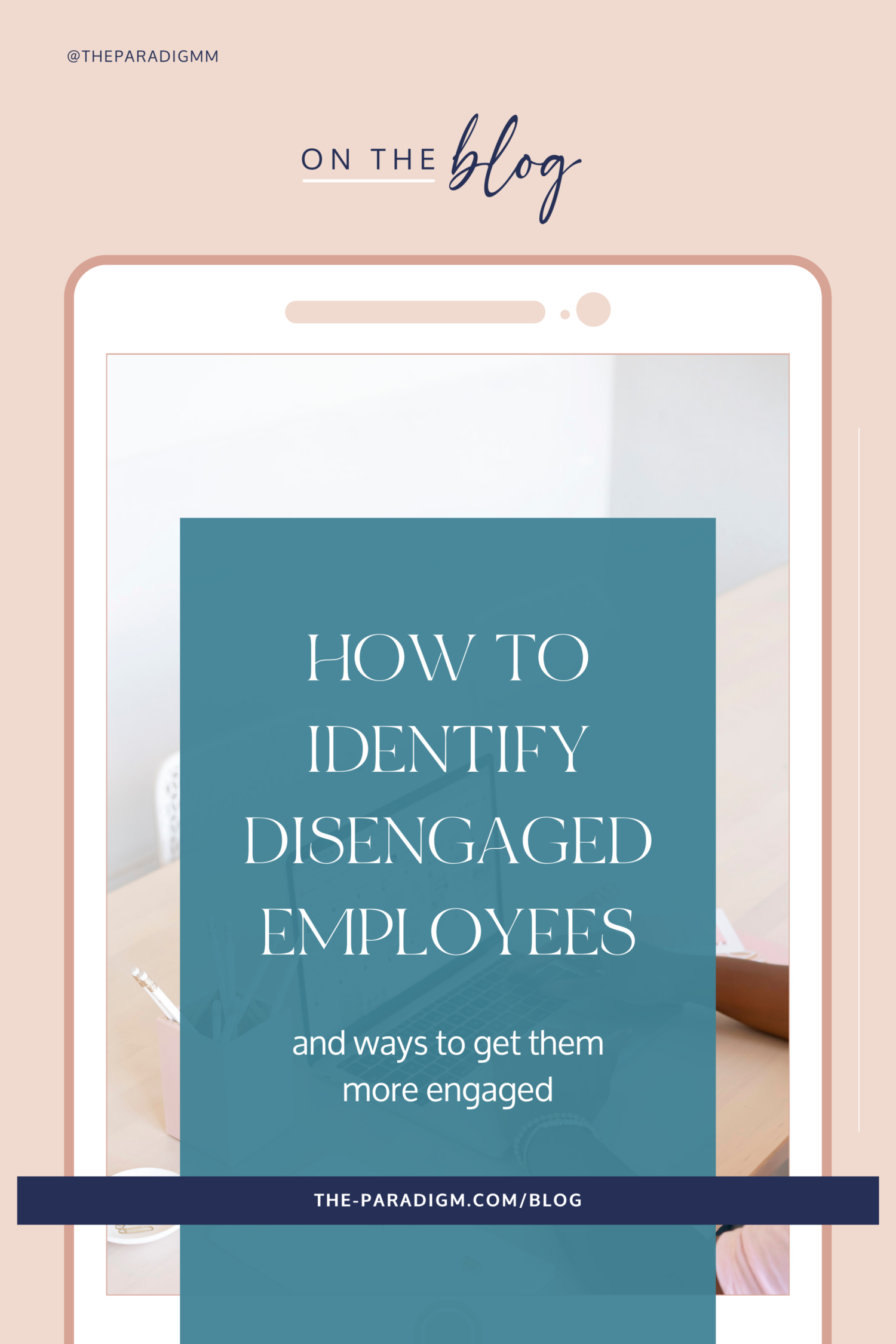March 1, 2022
It’s your job to make sure your team is bringing their best everyday! As a manager, it can be hard to find a way to start conversations that lead to higher retention and a better work environment for everyone.
More often than not, our team members don’t have the words (or the guts) to let us know what’s going on, but that doesn’t mean we aren’t still responsible for their engagement with their job. A high-performing team requires maintenance and accountability from their leader.
Engagement Checkpoints
If you notice an employee slacking but aren’t sure how to handle a situation, first try to identify a gap in where your team member is engaged. This way you can take intentional action to address where their gap in engagement resides.
I’ve learned that there are three places you can easily identify where an employee is lacking when it comes to engagement…
Short-Term Engagement
The employee is engaged in the day-to-day tasks and activities. The “work” is things they MOSTLY like doing so the annoying stuff is easy to roll off the back.
Looking for gaps in short-term engagement:
- Is the employee satisfied with their pay?
- Does the employee enjoy being around coworkers?
- Has the employee attempted to build relationships with team members?
- Does the employee enjoy showing up to work every day?
Long-Term Engagement:
The employee is acquiring skills that contributes to their overall career trajectory. They are confident that they are able to find a path forward and can see a return on investment on tenure.
Looking for gaps in long-term engagement:
- Is this employee overqualified for their position?
- Is the employee being challenged through their work?
- Are there any additional tasks I could give this employee that they would enjoy doing?
- Are there any trainings or certifications this employee would like to complete?
Mission:
The employee aligns their personal values with the mission and values of the company (also know as person-organization fit). By clearly defining your business’s mission, vision, values, and voice when hiring and managing employees, employees will know what is expected of them AND be committed to the goals of your business.
If you haven’t yet nailed down how you envision what your company culture looks like in action, I suggest filling out this worksheet first.
Looking for gaps in mission:
- Does this employee have confidence in the longevity of the company?
- Do they believe in the purpose or mission of the company?
- Do they know how their role fits into the overall business strategy?
- Do the values of the employee align with the values of the company?
Intentional Action for Disengaged Employees
Unfortunately, an employee who lacks engagement is contagious. When you identify an employee who is not engaged, try to put them in a bubble until the situation is properly addressed and resolved. This could look be limiting their work on group projects so they can focus on independent work. Their “bubble time’ could also be a perfect time to work on long-term engagement. Give the employee a project that they are interested in learning more about.
Here’s an example of what to say to an employee who seems to be disengaged,
“Hey, I noticed you are struggling a little, which is okay, it happens! However, we want to have a positive space to work so we will not allow your behavior to affect the rest of our team. Let’s talk about how we can tweak your day-to-day tasks to bring more of what you’re interested in doing into your position. Tell me what you’re interested in at the company…”.
Hold them accountable to being part of creating a positive space for everyone else. Even if an employee is struggling, their team members still need a positive environment to work in. Don’t like one bad apple spoil the bunch.
Increasing Engagement
Ways to Increase Short-Term Value for Employee Engagement
Compensation and Benefits
The easiest way to solve this problem is to provide enough compensation and high value benefits for you employee to be paid fairly while keeping the company viable. If your business can’t provide the benefits employees are looking for, try to come up with some low-cost, alternative perks for employees to show your appreciation.
Relationships
Having friends and feeling supported at work is an indicator for success and longevity at a company. When the purpose, mission, and values of your company are outlined in job ads, your company will likely be comprised of like-minded people. Companies must create space for employees to form authentic relationships at work so teams enjoy the time spent together. If you notice a disconnect among team members, don’t force it. On the other hand, if you notice a spark between team members, hold more team meetings, paid happy hours, and co-working sessions to further activate those relationships.
Day-to-Day Tasks
If an employee comes to you and says they’re bored with all the work they do, ask them to break down exactly what parts of the job are really annoying them. If they can’t come up with anything they enjoy doing for their position, maybe it’s not the right job for them (that’s a whole other discussion- you can’t fix that). Most of the time it’s just a couple things and you can provide them with tools to manage those tasks in a more effective way.
Mentorship
Find someone the employee can look up to, respect, and learn from. Don’t be afraid to find them a cross-functional mentor in another department. Maybe an employee is interested in marketing but has only ever done design, create an intentional mentorship between those two individuals so they can learn from one another and develop new friendships even if they aren’t working on the same projects every day. Ideally you can be the mentor an employee needs. Sharing with an employee what you are learning can create a really positive mentorship experience
Ways to Increase Long-Term Value for Employee Engagement
Long-Term Financial Well Being
A comp structure that rewards tenure is a great way to increase long-term financial well being.
Education and Upskilling
Create value in their education and provide upskilling that they can put on their resume. If an employee is moving up quickly in the company or has a lot of potential, consider paying for training courses or certifications to increase their education. The employee has the chance to go and learn new things, but they also will bring that knowledge back to your business.
If you go for the upskilling route, pick a course or program no longer than 9 months. You don’t want an employee to feel trapped in the position at your company because they haven’t completed the training or certification that you paid for. This will further decrease engagement. Short-term trainings/certifications are the way to go! (and you can write them off on taxes for you company).
Upward Mobility
Ensure that the employee can see, in title and/or compensation, what comes next for them in your company. If you’re a really small team and can’t exactly offer promotions, be transparent to employees about it. Under promising and overdelivering is the best way to go in this case. Give them more responsibility or value in other ways.
Aligning Mission and Values
People are living organisms, their experiences shape us and help us grow and change. Your business is a living organism too, so acknowledge that the company may grow and change and priorities might look different.
This is why it is important for you, as a manager, to be able to find the meaning behind what your company does, and relate it to you team members to establish and maintain engagement.
The secret behind being a good manager is being able to find those gaps between what your team actually cares about and what your company cares about. Find a link between the values of your company and the values of your employee and attach value to that link. Once you fill the gaps, employees will think of their position not just as a job, but as a career.
Don’t Make Assumptions
If you can’t answer questions regarding what is important to your employee in terms of engagement, ask them! You can’t just assume someone is or isn’t satisfied with their role. Assumptions are company killers. Having a difficult conversation is SO much better than making assumptions and being avoidant.
I gave you the tools you need to increase engagement, all you need to do is have valuable conversations with employees. Learn where employees are disengaged and take the right steps towards boosting their engagement!
If you aren’t ready to have those conversations but want to assess employee engagement, download our FREE employee engagement self assessment. Employees can fill out the survey and you can see exactly where they may be disengaged. Identify the gap, come up with a solution, and have a genuine conversation with your employee.

